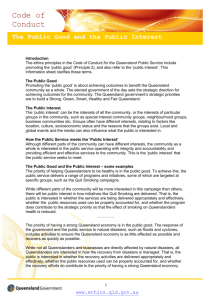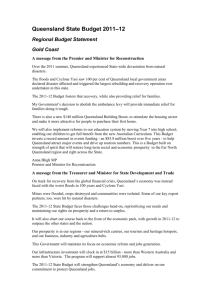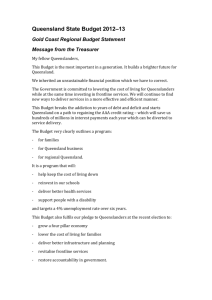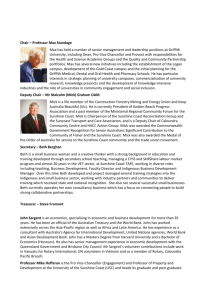South Coast Regional Budget Statement: Queensland State Budget
advertisement
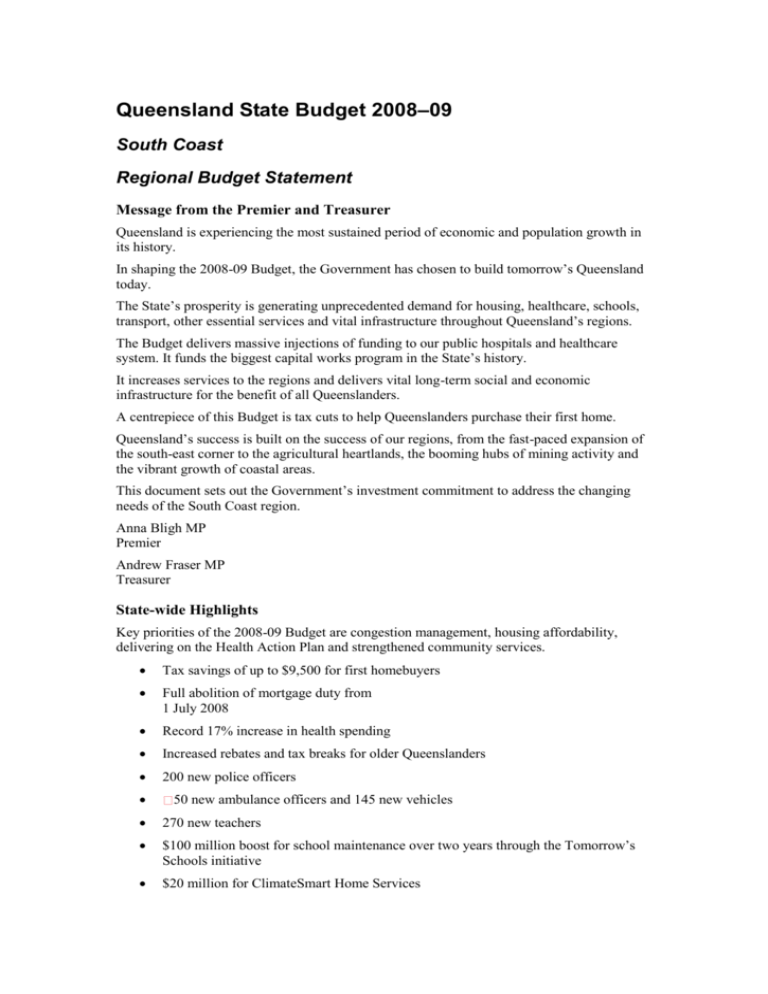
Queensland State Budget 2008–09 South Coast Regional Budget Statement Message from the Premier and Treasurer Queensland is experiencing the most sustained period of economic and population growth in its history. In shaping the 2008-09 Budget, the Government has chosen to build tomorrow’s Queensland today. The State’s prosperity is generating unprecedented demand for housing, healthcare, schools, transport, other essential services and vital infrastructure throughout Queensland’s regions. The Budget delivers massive injections of funding to our public hospitals and healthcare system. It funds the biggest capital works program in the State’s history. It increases services to the regions and delivers vital long-term social and economic infrastructure for the benefit of all Queenslanders. A centrepiece of this Budget is tax cuts to help Queenslanders purchase their first home. Queensland’s success is built on the success of our regions, from the fast-paced expansion of the south-east corner to the agricultural heartlands, the booming hubs of mining activity and the vibrant growth of coastal areas. This document sets out the Government’s investment commitment to address the changing needs of the South Coast region. Anna Bligh MP Premier Andrew Fraser MP Treasurer State-wide Highlights Key priorities of the 2008-09 Budget are congestion management, housing affordability, delivering on the Health Action Plan and strengthened community services. Tax savings of up to $9,500 for first homebuyers Full abolition of mortgage duty from 1 July 2008 Record 17% increase in health spending Increased rebates and tax breaks for older Queenslanders 200 new police officers 50 new ambulance officers and 145 new vehicles 270 new teachers $100 million boost for school maintenance over two years through the Tomorrow’s Schools initiative $20 million for ClimateSmart Home Services $20 million increase to develop community sport and recreation facilities $5.9 million boost to support front-line child protection workers The national Census telling it like it is Every five years the Census provides a snapshot of Australian society. It measures many characteristics including our age and birthplace, language spoken and religion, if we need assistance to perform everyday activities or to participate in community life and the work we do (paid or unpaid) and how we get there. What did the 2006 Census reveal about your community? Take a look below for a snapshot of life in Queensland’s South Coast region. The work we do Nurses, teachers, chefs, cashiers, site engineers, labourers, carers, sales representatives – South Coast residents work in a diverse range of jobs. Census data shows 13.1% of people living in the South Coast region are employed in the retail trade industry, while 12.1% work in the construction industry. Manufacturing (10.1%), accommodation and food services (9.2%) and healthcare and social assistance (9%) are the other major employment industries in this rapidly growing region. Our qualifications Queensland’s strong population growth has brought with it an increase in the number of skilled workers to our region. Just under 61%1 of people living in the South Coast region now hold ‘beyond2’ school qualifications – a 14.2 percentage point increase compared to 1996 Census results (see graph). Of these qualifications, 20.4% are degree or higher, 13.8% are advanced diploma or diploma and 37% are certificate level. Almost 30% of South Coast residents who identified with having a ‘beyond’ school qualification did not indicate the level of education received. How much we earn We’ve certainly experienced an increase in the cost of living over the years, and as it rises so too does our income. At the time of the 1996 Census, the median weekly household income for the South Coast region was $506. In 2006 the median weekly income for households in our region was $886 – that’s 75% more than we earned 10 years earlier3. 1 Aged 15 years and over with a usual residence in the South Coast region at the time of the 2006 Census. 2 ‘Beyond’ school qualification referred to as non-school qualifications in Census data. 3 Based on 2006 Census data. Household projections Families come in all shapes and sizes and between now and 2026 we can expect to see a lot more of them. But what type of family will occupy most Queensland homes? For the last decade most Queensland households have consisted of couples with children. However household projections forecast that, over the next decade and beyond, the make-up of homes throughout our State will dramatically change. Throughout our State an ageing population, declining fertility rates among younger couples, and baby boomers becoming ‘empty nesters’ will result in the number of couples without children and lone person households taking over as the most common types. Take a look to the right to see how households in the South Coast region are likely to change between now and 2026. It might be one of Queensland’s smallest regions, but with a population growth rate 50% more than the State’s average, the South Coast region is fast becoming one of the largest urban masses in Australia. Covering an area of 4,261 square kilometres or 0.2% of the State, our region is home to 14% of Queensland’s total population. Over 591,0001 Queenslanders now call the South Coast region home – that’s 3.3% more than the year before2. A sub-tropical climate, internationally renowned surf beaches, theme parks and marine playground, major world-class sporting events and a cosmopolitan lifestyle make our region sought after for its quality, unique environment and enviable and sustainable lifestyle. Add to this a diverse and vibrant economy that’s close to the business and career opportunities of the State’s south-east corner and you can see why more and more people are choosing this region in which to work, live and play. The Queensland Government recognises the role Queensland’s South Coast region has played in increasing our State’s prosperity and sustaining its economic and social growth. This Regional Budget Statement highlights the Government’s commitment to the region and its people. Population data as at 30 June 2007, Australian Bureau of Statistics, Regional Population Growth (cat no 3218.0). 1 Population data as at 30 June 2006, Australian Bureau of Statistics, Regional Population Growth (cat no 3218.0). 2 Healthy individuals and communities We are committed to improving and sustaining the health and wellbeing of all Queenslanders by investing in infrastructure and services that will strengthen our public health system, promote healthier lifestyles and enhance confidence and safety in our communities. As part of the Government’s continued commitment to meet the growing needs of the community, in 2008-09 spending on health infrastructure and initiatives in the South Coast region will include: $103.7 million to commence early on-site work for the $1.55 billion Gold Coast University Hospital $55.4 million to commence construction of the $240 million expansion of the Robina Hospital $11.5 million for the Robina Health Precinct $4.9 million to install a radiology system at the Robina Hospital. Initiatives in the South Coast region to enhance community safety through investments in police and emergency services infrastructure projects include: $7.3 million to construct the new Coomera Police District Office $3.6 million to construct a new 24-hour police station at Reedy Creek/Robina $3 million to upgrade Beenleigh and Mudgeeraba Police Stations $2.7 million to finalise the redevelopment of the Southport Fire and Rescue Station $2.4 million for the replacement of Surfers Paradise Police Station $2 million for a new fire and rescue station at Nerang at a total cost of $3.8 million $1.8 million to replace the regional emergency services training facility at Pimpama $1 million to refurbish the Burleigh Heads Ambulance Station $1 million to replace the ambulance station at Runaway Bay. The Government will continue its support for those in our community who are most vulnerable with commitments for the South Coast region in 2008-09 including: $33.1 million for the Home and Community Care initiative $17.2 million to support people with a disability through a range of programs $2.9 million for short-term and time-limited respite support for families of people with a disability $2.3 million over four years to establish new residential care facilities to accommodate young people with complex and extreme behaviours $2.1 million over four years to establish additional out-of-home care placements for children in care $1.7 million for youth development services to build independent living skills. Congestion management To help keep one of Australia’s fastest growing regions on the move, the Government will make a number of significant investments in the South Coast region in 2008-09, including: $127 million to extend the Gold Coast railway from Robina to Varsity Lakes $50.8 million towards finalising the planning for the Gold Coast Rapid Transit System from Parkwood to Broadbeach $37.7 million for improvements to the Pacific Motorway between Nerang and Tugun, with Queensland and Australian Government funding $20.9 million for the Robina Transit Oriented Development demonstration project being delivered in parallel with the new Varsity Lakes train station $20 million to continue widening the Gold Coast Highway to four lanes between Government Road and Robert Street $18 million to continue widening Hope Island Road to four lanes between Santa Barbara Road and Columbus Drive $10.7 million to complete bus priority works on the Gold Coast Highway south from Broadbeach $10 million to continue widening the Mount Lindsay Highway to four lanes between Rosia Road and Chambers Flat Road. Building infrastructure Planning and delivering the infrastructure needed to provide essential and efficient services to our rapidly growing community – now and in the future – is one of our key priorities. For many regions, growing populations have resulted in higher demand for energy. The Government’s commitment to the South Coast region includes $31 million for new and upgraded transformers at Southport, Cades County, Merrimac and Beenleigh and a new power line between Loganholme and Beenleigh substations. Regional development Regional development is at the heart of Queensland’s economic future and the Government is laying the foundation for future economic growth and prosperity for all Queenslanders by responding to the growth needs of the region. In 2008-09, the Government will invest $217 million in the 96-kilometre Southern Regional Water Pipeline between Cameron’s Hill in western Brisbane and Molendinar on the Gold Coast, linking the Wivenhoe system with supply sources including the Hinze Dam and the desalination plant under construction at Tugun. The Government will invest a further $106 million to improve the reliability and supply of water including: $100 million to increase the Hinze Dam’s total storage capacity $3 million to the Queensland Smart Water Facility at Griffith University’s Gold Coast Campus $3 million to complete the state of the art Pimpama Recycled Water Treatment Plant at the Gold Coast. Economic growth Queensland’s economic growth is supported by rising productivity and increasing labour force participation. The Government remains committed to expanding the productive capacity of the Queensland economy through initiatives that develop infrastructure, promote education and training and facilitate research and innovation. Commitments to the South Coast region in 2008-09 include: $12 million to commence constructing a new campus at Gold Coast Institute of TAFE to deliver high technology training $91.5 million to provide over 5.6 million hours of vocational education and training including $1.6 million to provide additional trades training places as a part of the Queensland Skills Plan. This is expected to create an additional 2,360 training places in the South Coast region by 2010 $4.2 million to provide employment and training assistance to 468 people and employ an Indigenous Employment and Training Support Officer. Housing affordability The Queensland Government is committed to improving housing affordability for those Queenslanders hardest hit by the current economic environment. In addition to the substantial tax relief to be introduced by the Government in 2008-09 for first home buyers, low-income families and individuals in the South Coast region will receive housing services and support in 2008-09 in the form of: $16.2 million to construct, purchase and upgrade public housing involving purchasing or completing 25 homes and commencing the construction of a further 27 homes $17 million to provide affordable rental accommodation $1.7 million to purchase land for future public housing $900,000 for community housing programs and services to address crisis and longterm housing needs $3.1 million for community renewal programs Education and early childhood development Giving every child every chance to learn in the best possible environment is a priority for the Government. This is reflected in our 2008-09 commitment to the South Coast region of an additional $4.1 million for maintenance programs and $83.8 million in capital works investment in schools, including: $26.6 million for a new high school at Ormeau $25.5 million for a new primary school at Western Oxenford $16.9 million for a new primary school at Cupania $9.7 million to complete stage 1B of Coomera Springs State School $2.8 million for a two-storey, eight-space teaching block at Greenbank State School $2.1 million over two years to redevelop the former Beenleigh Preschool as an early childhood education and care facility $266,000 towards the Nerang Early Years Centre. Prevention and early intervention The Queensland Government is focused on developing and supporting prevention and early intervention strategies or initiatives that are targeted to disadvantaged areas, individuals and/or population groups. In 2008-09 the Government will commit $3.3 million to support South Coast families, including early intervention programs to improve the safety and wellbeing of vulnerable children and their families. A further $1.3 million over four years will be allocated for a Family Intervention Service which will strengthen child protection, providing direct support to families in their own home. Managing climate change and protecting the environment The Government is committed to minimising harm to the environment by using and promoting modern and effective environmental management techniques. In 2008-09 the Government will allocate $30 million for new climate change initiatives from the proceeds of the Queensland Climate Change Fund. The first major initiative of the Fund is a ClimateSmart Home Service to provide Queenslanders with tools to monitor and reduce their energy use to deliver savings in household electricity costs and reduce greenhouse gas emissions. Helping Queenslanders under financial pressure With household budgets under increasing stress from rising interest rates, higher rents and mounting grocery and fuel prices, the Government is committed to taking the pressure off Queensland families. Each year the Government offers relief to many Queenslanders through discounts, rebates and subsidies to help improve their access to, and meet the cost of, a range of services including discounted rail and taxi fares, reduced car registration costs, exemption from the community ambulance levy and cheaper electricity bills. In 2008-09 these concessions are estimated to have a total value of around $1 billion. However the Queensland Government recognises more and more families are ‘doing it tough’ and is acting on its commitment to help Queenslanders make ends meet. On top of the existing concessions, the 2008-09 State Budget sees the implementation of a major housing affordability strategy that will provide relief for Queenslanders who are buying or renting their homes. The Government will also spend $570 million in 2008-09 in further relief as it tackles the rising cost of fuel by ensuring all Queenslanders receive the full 8.354 cents per litre fuel subsidy. Government services on the South Coast Beaudesert QGAP Centre 9, William Street, Beaudesert QLD 4285 E-Mail qgbeaudese@transport.qld.gov.au Telephone 5542 9400 Facsimile 5542 9450 Opening Hours: Monday, Tuesday, Thursday, Friday – 9am to 4.30pm; Wednesday – 10am to 4:30pm Beenleigh Department of Tourism, Regional Development and Industry 96 George Street Beenleigh QLD 4207 Telephone 3287 8585 Facsimile 3287 8589 Opening Hours: Monday to Friday – 8.30am to 5pm Beenleigh Department of Natural Resources and Water 32 Tansey Street Beenleigh QLD 4207 Telephone 3884 8020 Facsimile 3884 8079 Opening Hours: Monday to Friday – 8.30am to 4.30pm Gold Coast Department of Tourism, Regional Development and Industry Ground Floor 26 Marine Parade Southport QLD 4215 Telephone 5583 7599 Facsimile 5583 7591 Opening Hours: Monday to Friday – 8.30am to 5pm Robina Department of Natural Resources and Water Level 1, APVC Building 14 Edgewater Court Robina QLD 4230 Telephone 5583 1700 Facsimile 5583 1744 Opening Hours: Monday to Friday – 8.30am to 4.30pm Robina Department of Communities Đ Gold Coast Level 1, APVC Building 198 Robina Town Centre Drive Robina QLD 4230 Telephone 5583 4400 Facsimile 5583 4429 Opening Hours: Monday to Friday – 8.30am to 5pm Ipswich Department of Communities Đ Moreton Regional Office (Services Beaudesert Shire residents) 5-7 Wharf Street Ipswich QLD 4305 Telephone 3280 1031 Facsimile 3280 1035 Opening Hours: Monday to Friday – 8.30am to 5pm Other services Smart Service Queensland For information on all other Government services call 13 13 04 www.qld.gov.au State Emergency Service Telephone 132 500 Queensland Water Commission Telephone 1300 789 906 13 HEALTH Telephone 13 43 25 84
